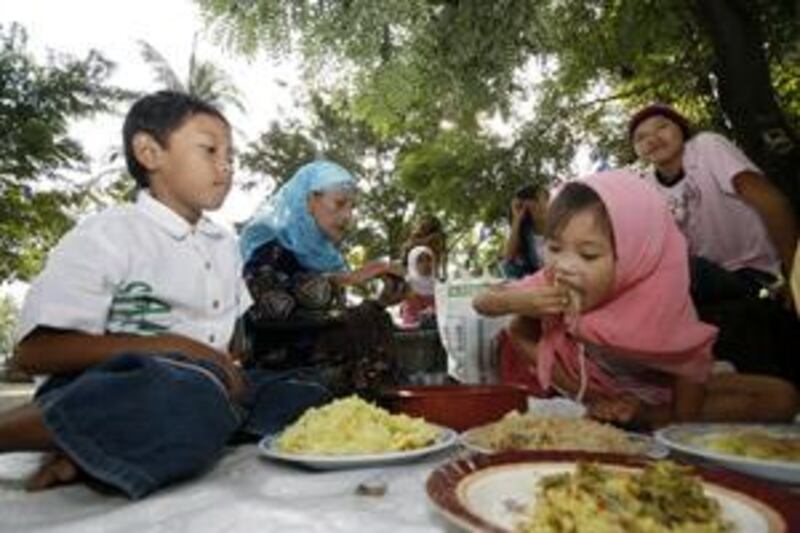At the earliest suggestion of another holiday season, the joke that there's only one fruitcake in the world that is eternally passed from one unwilling recipient to the next arcs its way back into my conscience like a tired boomerang. As with other special occasions for which I've been away from my family, Eid al Fitr brought home the realisation that holiday spirit - when we're lucky - is about being with the people we love. Traditions and values are mutable, and so is the spirit of celebration.
Food is at the heart of most holidays, and meals can be nourishing - and nurturing - on many different levels. All over the world, people honour special occasions with food, cooking and eating to express gratitude, to tell a story and usher in wealth and fortune. Eid al Fitr traditions vary among cultures and families. Despite it being a period of great celebration in the Gulf, our culinary lexicon offers no dishes unique to the holiday. Eid al Fitr is a family-oriented holiday and not as public a celebration as, say, UAE National Day. Typically, families gather in the home of a family elder for lunch. Throughout the Muslim world, everyday dishes are replaced by more luxurious ones. For instance, in Indonesia, fish is never served on Eid because it is considered too pedestrian.
Some foods that are closely associated with annual holidays are not strangers to the table the rest of the year. These include the tender, eggy challah bread served with honey during Rosh Hashanah (which coincided with Eid al Fitr this year), the richly spiced pumpkin pie of American Thanksgivings, grilled ballpark hot dogs on the Fourth of July, layer cakes on birthdays, lamb at Easter, and the standard French and Mexican fare dished out on Bastille Day and Cinco de Mayo.
Then there are those things, such as fruitcake, that are ephemeral and fleeting as the last few lebkuchen in the box of German holiday cookies. These have the amazing quality of seeming precious in the days leading up to their brief cameos but cumbersome and dated afterward. Case in point: candy corn on Halloween, bûche de Noël at Christmas, mooncakes during the Chinese mid-autumn festival, anything dyed red or pink for Valentine's Day, and goose (anyone who actually roasts a Christmas goose is automatically my hero).
New Year's Eve food traditions, often rife with symbolism, vary throughout the world. For wealth, Americans in the Deep South eat black-eyed peas, collard greens and cornbread. Greeks enjoy a cake baked with a coin inside called Vasilopita. Italians eat cotechino con lenticchie, sausage with coin-shaped lentils. In the Philippines, seven different round fruits symbolising luck, abundance and money are placed on the New Year's Eve dining table. For a cyclical sense of closure, the Dutch eat ring-shaped fritters called olie bollen. In some places, rice is the lucky food, while Japanese Buddhist temples customarily serve noodles. Spanish and Cuban people eat 12 grapes as the clock strikes midnight. Danes dig into boiled cod while German and Polish folklore stress the auspicious herring at the stroke of midnight.
Many Iraqis begin their Eid festivities with a breakfast of buffalo cream with bread and honey; in Egypt, ka'ak al Eid (small Eid cakes), and in Palestine, k'ak al-tamar (small date cakes) are ubiquitous during holidays, including non-Muslim ones. When I was growing up in Abu Dhabi, we often tried to simulate traditional Thanksgiving dinner with a frozen Butterball turkey and an assembly line of dishes whose charm must lie firmly in the realm of nostalgia and sentimentality, for I can't imagine anyone objectively liking the canned American seasonal food products we excitedly procured at Spinneys.
Since then, the closest I've come to witnessing the meal's iconic elements - in a motley mishmash - was watching my college roommate gleefully construct a "morning after" Thanksgiving sandwich: soft Wonderbread spread thickly with Miracle Whip and stacked with leftover shreds of turkey. "Are those beets?" I asked, watching as she sliced quivering rounds of cranberry jelly from an upright cylinder shaped just like the can from which it slid. She slapped them on top of the pile.
Thanksgiving 2007 fell on November 22, a day that fell auspiciously between the deaths of the great storyteller Norman Mailer and the great daredevil Evel Knievel. If I learnt anything from my first attempt at producing a meal that is iconic to so many people, it is that it is ill-advised (but not impossible) to imitate both men simultaneously. With delusional resolve, I wrote out a menu sure to satisfy even the most nostalgic Midwestern suburbanite.
When a freak snowstorm hit just after sundown, a weather advisory was issued warning drivers to stay off the roads. I spent the night alone with my turkey and 17 side dishes. The next year, I ate out and had a wonderful time eating mediocre restaurant food with people I love, while conversation and laughter swirled around me. Whether in Beirut for Eid al Fitr, at a friend's birthday soiree, at a cousin's wedding anniversary party or in a crowd of a million people gathered on New Year's Eve, I've always loved witnessing new ways to celebrate and rejoice. What's imperative for a special day off? My vote goes to openness, generosity, a positive attitude and a big appetite.










